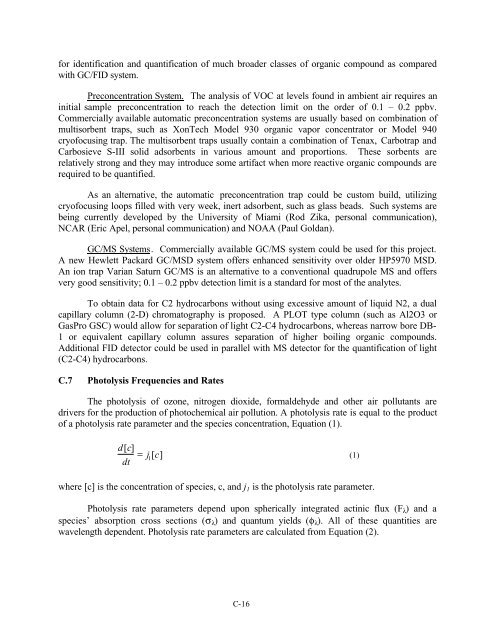Central California Ozone Study (CCOS) - Desert Research Institute
Central California Ozone Study (CCOS) - Desert Research Institute
Central California Ozone Study (CCOS) - Desert Research Institute
Create successful ePaper yourself
Turn your PDF publications into a flip-book with our unique Google optimized e-Paper software.
for identification and quantification of much broader classes of organic compound as compared<br />
with GC/FID system.<br />
Preconcentration System. The analysis of VOC at levels found in ambient air requires an<br />
initial sample preconcentration to reach the detection limit on the order of 0.1 – 0.2 ppbv.<br />
Commercially available automatic preconcentration systems are usually based on combination of<br />
multisorbent traps, such as XonTech Model 930 organic vapor concentrator or Model 940<br />
cryofocusing trap. The multisorbent traps usually contain a combination of Tenax, Carbotrap and<br />
Carbosieve S-III solid adsorbents in various amount and proportions. These sorbents are<br />
relatively strong and they may introduce some artifact when more reactive organic compounds are<br />
required to be quantified.<br />
As an alternative, the automatic preconcentration trap could be custom build, utilizing<br />
cryofocusing loops filled with very week, inert adsorbent, such as glass beads. Such systems are<br />
being currently developed by the University of Miami (Rod Zika, personal communication),<br />
NCAR (Eric Apel, personal communication) and NOAA (Paul Goldan).<br />
GC/MS Systems. Commercially available GC/MS system could be used for this project.<br />
A new Hewlett Packard GC/MSD system offers enhanced sensitivity over older HP5970 MSD.<br />
An ion trap Varian Saturn GC/MS is an alternative to a conventional quadrupole MS and offers<br />
very good sensitivity; 0.1 – 0.2 ppbv detection limit is a standard for most of the analytes.<br />
To obtain data for C2 hydrocarbons without using excessive amount of liquid N2, a dual<br />
capillary column (2-D) chromatography is proposed. A PLOT type column (such as Al2O3 or<br />
GasPro GSC) would allow for separation of light C2-C4 hydrocarbons, whereas narrow bore DB-<br />
1 or equivalent capillary column assures separation of higher boiling organic compounds.<br />
Additional FID detector could be used in parallel with MS detector for the quantification of light<br />
(C2-C4) hydrocarbons.<br />
C.7 Photolysis Frequencies and Rates<br />
The photolysis of ozone, nitrogen dioxide, formaldehyde and other air pollutants are<br />
drivers for the production of photochemical air pollution. A photolysis rate is equal to the product<br />
of a photolysis rate parameter and the species concentration, Equation (1).<br />
d[c]<br />
= j<br />
dt<br />
1<br />
[c] (1)<br />
where [c] is the concentration of species, c, and j 1 is the photolysis rate parameter.<br />
Photolysis rate parameters depend upon spherically integrated actinic flux (F λ ) and a<br />
species’ absorption cross sections (σ λ ) and quantum yields (φ λ ). All of these quantities are<br />
wavelength dependent. Photolysis rate parameters are calculated from Equation (2).<br />
C-16
















